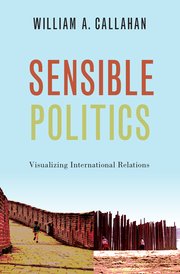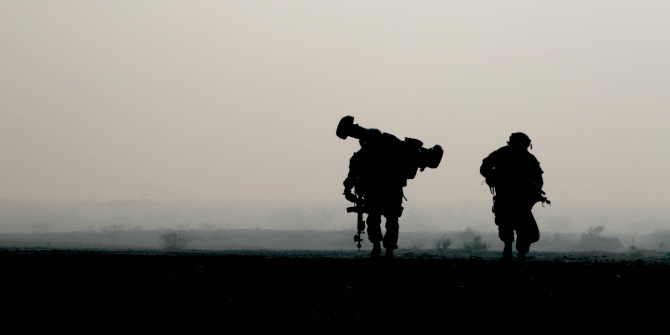In Sensible Politics: Visualizing International Relations, William A. Callahan focuses on the role of visuality in world politics, pushing ideas on what the visual can do through a broad investigation into all things visible and everyday, ranging from film and borders to beauty pageants and maps. Offering a multisensory reading experience in its own interplay of image and text, Sensible Politics is a key marker to where thinking on theories of world order goes next, writes Sophie Harman.
Sensible Politics: Visualizing International Relations. William A. Callahan. Oxford University Press. 2020.
 Reading and writing a review at the height of a global pandemic is a sensory experience. Your nerves are slightly frayed from worry for friends and colleagues, you are reading in a different location on account of ‘lockdown’ to prevent the spread of COVID-19, and in taking the time to read and engage in scholarly work, you are trying to redirect mind and body to something else. William A. Callahan, in his new book Sensible Politics, brings to the fore such sensory engagements with world politics, whereby we are pushed ‘to think of politics in a different register that is more attentive to the visceral politics of everyday bodily practices, wherein both elites and non-elites creatively participate in affective communities of sense. Sensible Politics is about multisensory politics; but it also looks beyond icons and ideology to ‘‘what makes sense’’ in the pragmatic politics of everyday life’ (310).
Reading and writing a review at the height of a global pandemic is a sensory experience. Your nerves are slightly frayed from worry for friends and colleagues, you are reading in a different location on account of ‘lockdown’ to prevent the spread of COVID-19, and in taking the time to read and engage in scholarly work, you are trying to redirect mind and body to something else. William A. Callahan, in his new book Sensible Politics, brings to the fore such sensory engagements with world politics, whereby we are pushed ‘to think of politics in a different register that is more attentive to the visceral politics of everyday bodily practices, wherein both elites and non-elites creatively participate in affective communities of sense. Sensible Politics is about multisensory politics; but it also looks beyond icons and ideology to ‘‘what makes sense’’ in the pragmatic politics of everyday life’ (310).
Visceral, multisensory and the pragmatic politics of everyday life sum up the discombobulating experience of living through a global pandemic. But as Callahan deftly argues, Sensible Politics is not just about the deconstruction of political events such as COVID-19 (or surveillance, quarantine and leprosy, as he explores in Chapter Eleven); it is more about the ‘productive tension’ between such visibility and visuality – how the visual can ‘do’ things.
It is the doing that presents the real promise of the book: to develop our understanding of visual politics beyond the visible – how we read and deconstruct the politics of the visual – to visuality, what the visual can do, how it can construct social and world orders. This is a big claim. Can a garden construct a world order? Absolutely. Gardens are heterotopias, Callahan argues, and ‘garden-building is theory building: by producing new sites and sensibilities, it creatively shapes our understanding of IR’ (270). The fun of reading this book is not just the ideas within it, but how Callahan goes on to explore them. Visual and aesthetic politics have gone beyond their initial turns in International Relations to become a sub-field of innovative theory and research, and a handful of scholars have started to explore ‘sensory democracy’ and politics. In Sensible Politics, Callahan pushes these ideas on what the visual can do in world politics, through a broad investigation into all things visible and everyday, from the sites of his previous work – film, borders, China – to contentious issues of global politics such as the veil, beauty pageants and maps.

Feature image credit: Photo by Jose Ros Photo on Unsplash.
For Callahan the making of theory, social orders and world orders derives from the ‘dynamic dyad’ between visibility and visuality, where visibility relates to the search for meaning, social constructions and the politics of representation of the visual; and visuality to how visual artifacts can ‘do’ things. Here Callahan builds on the work of prominent scholars such as Roland Bleiker, Lene Hansen, Emma Hutchison, Jacques Ranciére and Michael J. Shapiro. However, he also extends their established ideas on affective registers and sensory politics by drawing on an assemblage of concepts from western, Chinese and Asian thought. This is a strength of the book. Callahan deftly explores the self-evident ways in which the image and the text have always been in dyadic encounters with each other in Chinese and Asian thought, and effectively relates such dyadic interplays to the wider politics of China as imperial and imperial subject. As Callahan argues: ‘what is most interesting about these Chinese dyads is the general lack of stable canonic definition: there is no orthodoxy, and the dyads’ contingent flexibility demands that we make sense of each dynamic through continual interpretive practice’ (224). Visual and multisensory politics have always existed in world making and international relations; it just depends where you look.
At times this reads as a book of issues or hobbies that occupy Callahan’s mind, which he has then thought about within the context of his wider work. Why these specific sites or artifacts are chosen for their world-making potential and how they inter-relate are not always clear. Chapter Eight on ‘The Sartorial Engineering of Race, Gender, and Faith’ and its discussion on the veil and beauty pageants made me wince in parts, and at times it seemed the subjects were selected more for their contentious content than for their wider contribution to the argument. Callahan does acknowledge his own positionality in writing about such topics and the need to ‘be careful in our analysis’ (181), and he is attentive to established scholarly work on these issues. Contention and my sensory ‘wince’ are perhaps two of the affects Callahan seeks to produce and thus the chapter and its main argument make their point. In part, the site selection does not matter and does not distract from their relevance, but they also read as the sort of choices you can get away with once you are an established Professor. This is less a criticism of the book and more of a reflection on what scholars can ‘do’ within the field of IR and perhaps when they are allowed to do it. Callahan is not seeking permission here, and as such, he can play not only with site selection but also with his writing style.
A common question asked to scholars interested in visual politics is, given the emphasis on the visual, why recourse to the written word to explain and give meaning? Callahan uses this question to explain why he wrote the book, and makes clear that he also works in visual forms, most notably short documentary film. However, he also goes much further than this in the form in which he writes the book. The book is in many ways back to front, with the conclusions reading as introductions, with different chapters contributing to the wider narrative but seeming as individual essays, and the inclusion of visual images throughout. The result is that Sensible Politics is the one book I’ve read on visual politics that applies critical thinking on what the visual can do – rupture, appeal to the senses, disorient – to the written word. The written word exists in ‘dynamic dyad’ with the images in the book, while the structure and the chapters interline to create a multisensory experience in reading it: Callahan is not just telling us about such dyadic interactions, he is showing us.
There are wider questions and conversations I had in my mind when reading Sensible Politics. There are small snippets throughout the book, such as the discussion on the informed consent of participants in one of Callahan’s films, Toilet Adventures (83), that point to much larger questions, such as how do we account for ethics in this way of theory making? If images can create war, how do we hold them to account for their actions? What is the agency of beauty queens in the nations they are constructing? In sum, if visual artifacts do world politics, how can we understand, account for and contest their agency? The answers to these questions are as exciting as the questions posed within the book, and thus make Sensible Politics a key marker to where thinking on theories of world order goes next.
Note: This review gives the views of the author, and not the position of the LSE Review of Books blog, or of the London School of Economics.
Banner image credit: ‘171022-N-VR594-0004’. ‘Big eyes’ binoculars are used to scan the horizon as the guided-missile cruiser USS Princeton (CG 59) transits the Strait of Hormuz Oct. 22, 2017. U.S. Navy photo by Mass Communication Specialist 3rd Class Kelsey J. Hockenberger. Image by US Department of Defense Current Photos, licensed as Public Domain.








4 Comments